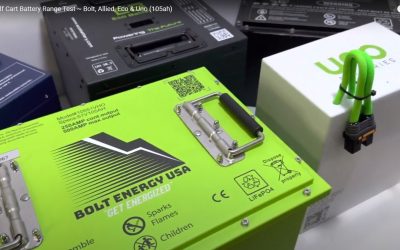How Often Should You Charge Lithium Golf Cart Batteries?

How Often Should You Charge Lithium Golf Cart Batteries?
Lithium batteries have become the preferred choice for golf carts due to their efficiency, longer life span, and lower maintenance needs. However, to get the most out of them, it’s important to follow proper charging practices. Unlike lead-acid batteries, lithium batteries have different characteristics and charging needs. Below, we’ll explore how often you should charge lithium golf cart batteries and the key factors you should keep in mind.
1. Charge After Each Use for Optimal Performance
A key advantage of lithium batteries is that they do not have a “memory effect.” This means that you can charge the battery after each use, whether it’s been fully depleted or not. Frequent charging is recommended as it helps keep the battery topped off and ensures you’re always ready for your next round of golf.
- Partial Charging: Lithium batteries thrive on partial charging. You can top off the battery at any point without reducing its overall lifespan. This makes lithium batteries much more flexible compared to older lead-acid batteries, which required you to wait until they were fully discharged before recharging.
- After Each Round: If you’ve used the golf cart for an extended period, such as completing a round of golf or a long trip, it’s best to plug it in for a charge immediately after use. This ensures the battery remains charged and ready for the next use. While lithium batteries hold their charge longer than lead-acid, it’s still ideal to charge them regularly after heavy use.
2. Avoid Full Discharges
While lithium batteries are durable and long-lasting, they should not be regularly discharged to 0%. Keeping the battery charge above 20% helps maintain the health of the battery over time. A deep discharge, where the battery level falls below 10% regularly, can shorten the overall cycle life of the battery.
- Why Avoid Deep Discharges?: Lithium batteries are designed to be recharged before they are fully drained. Regularly allowing them to reach very low charge levels can strain the battery and lead to reduced capacity over time. For optimal battery longevity, it is recommended to plug the battery in when it reaches around 20% charge.
- Battery Management Systems (BMS): Most modern lithium batteries come with a built-in BMS, which helps monitor and protect the battery from over-discharging. If the charge drops too low, the BMS may prevent further discharge to protect the battery. However, it’s always best not to rely on this feature regularly and instead keep the battery charged.
3. Charging Frequency Based on Usage
The frequency of charging depends on how much you use your golf cart. Here are two scenarios:
- Daily Use: If you use your golf cart daily or for long hours, it’s essential to charge the battery after every use. Lithium batteries can handle frequent charging and don’t need to be fully discharged, so you can charge them every day even if you haven’t used the full capacity.
- Occasional Use: If you use your golf cart less frequently, such as only on weekends, you might only need to charge the battery once or twice a week. Keep in mind that lithium batteries have a low self-discharge rate, meaning they can hold their charge for extended periods without needing to be topped off daily.
4. Battery Life and Cycle Count
Lithium batteries typically have 2,000 to 5,000 charge cycles, which means each time you recharge the battery counts as one cycle. However, partial charging does not count as a full cycle, so regularly topping off the battery will not significantly reduce its overall cycle count.
- Maximizing Life Span: By charging the battery after every use and avoiding deep discharges, you can maximize the life of your lithium battery. With proper care, lithium batteries can last up to 10 years or more, significantly longer than traditional lead-acid batteries, which often need replacing every 3-5 years.
- Balancing the Battery: While partial charges are encouraged, it’s also important to fully charge the battery periodically (e.g., once every 2-4 weeks). This helps balance the cells in the battery and ensures that all cells are equally charged. This full charge cycle can extend the overall life and improve the performance of the battery.
5. Charging Time
Lithium batteries charge much faster than lead-acid batteries, often taking only a few hours to reach full capacity. However, there is no need to leave the battery plugged in overnight, as lithium chargers are designed to stop charging once the battery is full. Overcharging is not an issue with lithium batteries because they use smart chargers with automatic cutoff features.
- No Overcharging Concerns: You can safely charge the battery after each use without worrying about overcharging or damaging the cells. The charger will stop delivering power once the battery reaches 100%, so there’s no risk of leaving it plugged in for too long.
6. Charging During Storage
If you plan to store your golf cart for an extended period (like during the off-season), you should charge the battery to around 50-80% before storage. Lithium batteries have a low self-discharge rate, so they can hold this charge for several months without needing a top-up. During storage, it’s essential not to leave the battery completely full or fully discharged, as either extreme can reduce its overall lifespan.
- Periodic Checkups: If you’re storing your golf cart for more than a few months, it’s a good idea to check the battery level periodically and recharge if it drops below 50%. Most lithium batteries will retain their charge for long periods, but checking every few months ensures they remain healthy and ready for use.
Conclusion
The frequency with which you charge lithium golf cart batteries depends on how often you use your cart. Generally, it’s a good practice to charge the battery after each use, especially if you’ve used it heavily. Avoid deep discharges and aim to keep the charge above 20%, and top-off the battery regularly without worrying about memory effects. For longer storage periods, charge the battery to about 50-80% and check on it periodically.
With these charging habits, you’ll extend the life of your lithium battery, enjoy more consistent performance, and ensure your golf cart is always ready to go.






